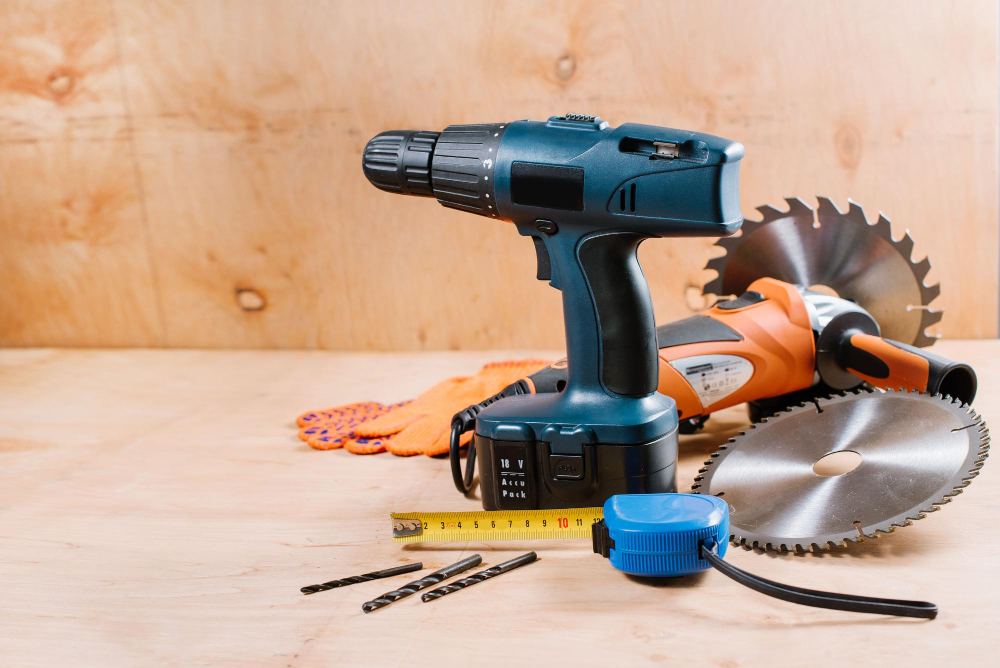Some homeowners with the necessary skills prefer to tackle their home improvement projects. Do-it-yourself (DIY) home improvement projects can help you save hundreds to thousands of dollars and can be an excellent pass-time activity.
That said, whether you’re building new cabinets, putting together furniture, or just doing some regular maintenance around your home, you may need a few essential power tools in your arsenal.
What Is A Power Tool?
Power tools are devices or machines which are operated by an additional power source or mechanism other than the human body. In general, the most common types of power tools utilize electric motors and are powered by electricity. Furthermore, you can also find power tools that use compressed air and internal combustion engines fueled by gasoline, although these generally apply to garden tools.
You can easily find and purchase power tools in your local hardware store, home improvement shops, and specialty power tool stores like Data Power Tools in the UK. Most of these stores may also have online shops that provide a more comprehensive range of power tools and other home improvement necessities. If you’re interested, you can check online for more detailed information.
6 Power Tools For The Home Improvement DIYers
As a newbie DIYer, you may find that there are dozens of power tools for different purposes. However, to help you get started, here are the key power tools you’ll probably use the most in your home improvement projects.
1. Cordless Drill
A cordless drill is an electric drill powered by rechargeable batteries. It’s one of the most common and important tools in any garage or workshop. In fact, a cordless drill is arguably the first power tool that every DIYer should have. It is for almost every home improvement task, from installing shelves to building an entire deck, making it highly invaluable.
You may find a corded drill that’s more powerful, leaner, and lighter than cordless ones. However, they’re also louder, restrict mobility, and are not as convenient to use. Consequently, cordless drills are the preferred option of most home DIYers.
In general, a cordless drill has two primary functions: putting holes into wood, walls, and other hard surfaces and mounting screws and fasteners onto surfaces. When purchasing a cordless drill, keep in mind that the higher its voltage is, the more power it can provide.
2. Circular Saw
Circular saws are lightweight cutting tools that allow you to rip long lumber or large panels like plywood. It features a toothed or abrasive blade or disc to make different cuts in the material in a circular motion that spins around an arbor.
In general, the material to be cut by the circular saw is often held by a clamp or secured in a vise, so the saw can advance and cut the material slowly. Most circular saws are powered by electricity; however, you can find models powered by a hydraulic or engine motor.
3. Jigsaw
A jigsaw is a small power tool that’s mainly used for woodworking. However, when fitted with the right blade, a jigsaw can also cut fiberglass, steel, and drywall, adding to its versatility and making it more valuable in your workshop. Unlike circular or other power saws, a jigsaw uses a toothed, straight blade and makes a rapid up-and-down motion to cut materials.
Also, while most power saws are known to make straight-line cuts, a jigsaw is often used for cutting curved lines, allowing you to cut more complicated and delicate patterns and shapes. With a jigsaw, not only can you cut complex curves and forms into a material, but it can also help you make crosscuts on a board or finish inside corner cuts that you started with a circular saw.
4. Orbital Sander
Most home renovation and improvement projects that involve wood will require some kind of sanding. And instead of breaking out in a sweat to manually sand the material, it’s best to invest in an orbital sander instead.
This handheld power tool features a sanding blade with random orbit action to sand wood surfaces. An orbital sander can do the sanding task in a fraction of the time and provide superior results than manual work.
Most power sanders are random orbital, meaning the angle of rotation with the head varies. Thus, it doesn’t leave a noticeable scratch pattern on the wood and quickly works to ease the edges of finished designs.
An orbital sander uses sandpaper disks that are attached with either a pressure-sensitive adhesive or a hook-and-loop system that makes it easier to replace and switch sandpapers of different grits.
5. Impact Driver
An impact driver may look similar to a cordless drill; however, it uses a brute force, hammering-like action to get the job done.
The impact driver uses concussive blows with a bit of rotation to drive screws onto a material with an incredible amount of force. Its mechanism applies constant torque to provide you with a wide range of uses, from building shelves to removing stubborn deck screws.
Most impact drivers feature a keyless chuck that accepts a variety of attachments, including hex-shanked drivers and bits.
6. Angle Grinders
Angle grinders, also known as side grinders or disc grinders, are another must-have tool for every DIYer. This portable handheld power tool is used for grinding and polishing jobs to smoothen surfaces.
The motor of an angle grinder drives a right-angled gear head with a thin cut-off disc or abrasive disc to smoothen the surface. When worn out, you can easily replace these discs. In general, angle grinders also have an adjustable guard and a side handle, so you can use them for two-handed operation.
Depending on how fast they operate, some angle grinders can also be used as a sander by attaching a sanding disc.
Takeaway
To complete a DIY project, you need to have the right set of power tools. Depending on your budget and typical home improvement projects, the above power tools can help get things done faster and with less effort.

